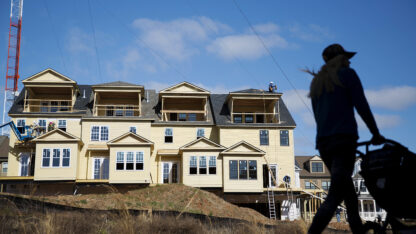Why more women live in major East Coast counties while men outnumber them in the West

Anyone who has suspected that there are more women than men where they live, or vice versa, will find fodder for their suspicions in new data from the U.S. Census Bureau.
Whether it refutes or confirms their suspicions likely depends on where they live.
Women outnumber men in the largest urban counties east of the Mississippi River, along the Eastern Seaboard and in the Deep South, while the West skews male, according to data released last week from the 2022 American Community Survey 5-year estimates, the most comprehensive source of data on American life. Those numbers were also backed up by age and sex figures from the 2020 census released earlier this year.
There are limitations to what can be concluded from the data. Still, Nancy Averbach, 57, doesn’t find the numbers surprising. She lost her husband eight years ago, and has since found it hard to meet a compatible partner.
Across the U.S. in 2022, the most recent year that figures are available, there were 96.6 adult men for every 100 adult women — and in the Atlanta suburb of DeKalb County, where Averbach lives, that ratio was 87.1, according to the survey. An equal ratio of men to women would be 100.
“It’s really tough to find quality men who share similar values,” Averbach said. There aren’t many singles groups that cater to her age group, she says, and when such groups put on events, they usually attract more women than men.
Her county has a low sex ratio, which means there are more women than men. A high ratio indicates there are more men than women.
The sex ratio numbers don’t reflect sexual preference, gender identity or whether those surveyed are looking for partners. The figures also don’t reflect intersex people, who, historically, have had relatively scant data collected on them.
The ratios vary by geography, in part because of the presence of certain institutions and industries with gender imbalances. In the most populous counties in the West, this is especially discernible. San Diego, for instance, has several male-dominated military bases, which is reflected in the sex ratio. In Austin, San Francisco, Seattle and San Jose there are plentiful jobs in tech, a sector where men account for around three-quarters of the workforce.
This is in contrast to areas with large numbers of colleges or universities, which typically have more women, according to a Census Bureau report from May.
Adding to the imbalance are the effects of historic racism in the U.S., including high rates of incarceration and the mortality gap, which have lowered the number of men in some communities, said Karen Guzzo, director of the Carolina Population Center at the University of North Carolina.
Among U.S. counties with 500,000 residents or more, the areas where adult women outnumber adult men most noticeably were in Baltimore, New York, Atlanta and Philadelphia, as well as Birmingham, Alabama; and Memphis, Tennessee; where the ratios ranged in the mid-80s.
The biggest imbalances of men to women, with ratios above 103 for those age 18 and over, were recorded in the West, in counties that are home to Colorado Springs, Colo.; and Austin, as well as California counties that are home to San Francisco, San Jose and Bakersfield, where agriculture and energy are two of the biggest industries.
At birth, the sex ratio in the U.S. has historically been 105 men for every 100 women. The ratio inverts around age 30. Since the mortality rate is higher for men than it is for women at almost every age group — due to violence, drinking, smoking, job hazards and suicide — that ratio decreases with age, until at age 90 or above there are typically about two women to every man.
Compared to the previous decade though, more men are now living into older age, according to the 2020 census.
Michal Naisteter, a professional matchmaker in the Philadelphia area, has given the imbalance some thought — and mostly in terms of the dating market because of her work. She thinks single women are more likely than men to live within the city limits of Philadelphia, but that single men are more willing to commute from the suburbs than vice versa.
She advises people looking for a partner to put in the effort, perhaps even to expand the geographical reach of their day-to-day lives.
“It should take work,” Naisteter said. “Because nothing is sweeter than something you have to work for.”
In communities with more men than women, people tend to marry at an earlier age than in places where women outnumber men. Women are more likely to live with a partner without getting married in places where they outnumber men, and if they do marry, it is more often to men who are less educated or earn less than they do, Guzzo said.
That’s not likely to happen with Averbach, who is doing just fine on her own in suburban Atlanta.
“Why would I want to settle?” she said. “I don’t need a guy to make me happy.”








